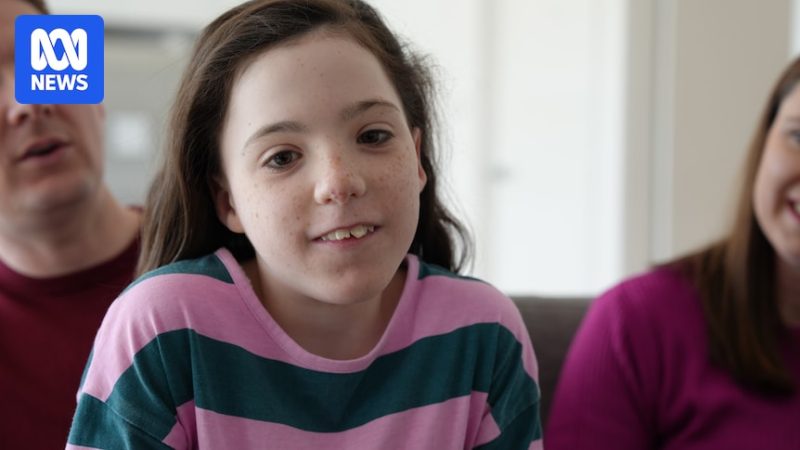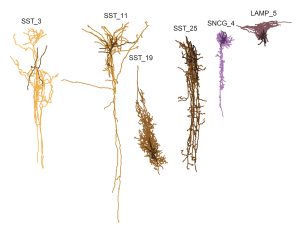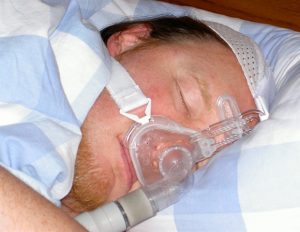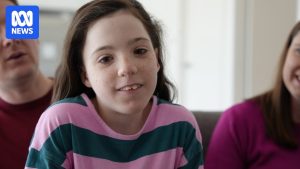Just 30 people in the world are known to have Beck-Fahrner syndrome, but it’s likely more common than figures suggest

It’s rare to find Ashley Clifford without a ball in hand.
“She is obsessed with balls,” her mother, Belinda Clifford, said.
“You will always find her with one — in the shower, in her bed, in the car — absolutely everywhere.”
But despite playing like any other ordinary child, the Canberran 10-year-old lives with a rare genetic disorder.
Ashley is one of only a few dozen people in the world confirmed to have Beck-Fahrner syndrome, a condition caused by a mutation of the TET3 gene.
Ashley Clifford’s mother Belinda (right) says the family went through a “bouncing ball” of specialist appointments to get her diagnosis. (ABC News: David Sciasci)
It affects a person’s development, causing intellectual disability, developmental delay, growth abnormalities and neuro-behavioural issues, including autism, attention deficit hyperactivity disorder (ADHD) and anxiety.
The impact the syndrome can have on a person’s day-to-day life varies greatly.
For Ashley, it affects almost every aspect of her life.
Her intellectual disability means she struggles to dress herself, tie her shoelaces, use a knife and fork or determine between a plate and a bowl.
She has also been diagnosed with ADHD and autism, so she often experiences sensory overload, relies on routine and has difficulty picking up on social cues.
Ashley Clifford’s mother Belinda says it’s rare to find her without a ball in her hand. (ABC News: David Sciasci)
And then there’s her growth abnormalities, including being small in stature, having odd-sized kidneys and an unusually shaped sinus.
“We have daily life challenges, it’s continuous,” Ms Clifford said.
“Right down to the things people take for granted — brushing their child’s hair, holding their child’s hand.
“We often find Sophie, our younger daughter, stepping in to help her because she needs constant, one-on-one help.”
Geneticist says syndrome likely ‘way more common than we know’
Jill Fahrner, the Director of the Epigenetics and Chromatin Clinic at Johns Hopkins University in the United States, was part of the team that identified the first case of what is now known as Beck-Fahrner syndrome in 2016.
By 2020, 11 people from eight families had been identified with the specific genetic mutation and Dr Fahrner and her colleagues published a paper about the condition in the American Journal of Human Genetics, marking its debut into the broader medical sphere.
Dr Jill Fahrner says it’s likely there are many more cases of Beck-Fahrner syndrome than have been identified. (Supplied: Johns Hopkins University)
“We only know of about 30 people that have been reported in the medical literature with this condition but I am aware of about 75 to 100 individuals who are suspected of having it in the world,” Dr Fahrner said.
The clinical geneticist is confident Beck-Fahrner syndrome is far more common than those figures indicate.
She suspects many people have been diagnosed with one or more symptoms but never had genetic testing to determine what is causing those symptoms.
“I know of a lot of people who had genetic testing many years ago and they didn’t find it because we didn’t know about it,” Dr Fahrner said.
“Then when they reanalysed the data from that genetic test, they found it.
“And the fact we have such a broad spectrum of symptoms, ranging from very severe to mild, increases the likelihood that this is way more common than we know.”
The pathway to diagnosis for Ashley and her parents was gruelling, time-consuming and expensive.
‘At each appointment we were passed to another specialist’
Ashley Clifford had an ultrasound at just three days old. (Supplied: Belinda Clifford)
Other than Ashley always measuring on the smaller side, it was an uncomplicated pregnancy for her mother.
But within days of giving birth in 2014, she and her husband, Hugh, realised their daughter’s life might come with significant challenges.
“We had an ultrasound three days after she was born and the doctor who was called in to look at the scan turned around and said, ‘Your daughter may never walk,'” Ms Clifford said.
“At that point, they thought she had spina bifida.”
That was the start of what Ms Clifford described as “the bouncing ball” of specialist appointments.
“After we went to the paediatrician, we went to the kidney specialist,” Ms Clifford said.
“We had eye issues, hearing issues, feeding issues — it really was just a continuation of doctors and at each appointment, we were passed to another specialist because they just could not work out what Ashley had.”
Ashley Clifford on her first birthday. (Supplied: Belinda Clifford)
As she grew, Ashley struggled to hit her developmental milestones.
“Whether it was sitting up, rolling over, walking or climbing, everything was delayed,” Mr Clifford said.
“I think when some of the other kids her age were standing up by themselves, Ashley was still trying to crawl.”
As the years rolled on, Ashley’s diagnoses rolled in: intellectual disability, autism and then the ADHD diagnosis.
Regular genetic testing revealed nothing conclusive until 2018, when the TET3 gene mutation was identified.
Ashley Clifford on her second birthday. (Supplied: Belinda Clifford)
At that stage, though, Dr Fahrner and her team’s research wasn’t published.
“It didn’t give us the full answer but it gave us the first step towards figuring out what was actually going on with Ashley,” Ms Clifford said.
The family was told to be patient while more people with the genetic mutation were found and further research could be done.
“Then we had a meeting with Ashley’s genetic team in 2020 and they told us about the paper and the 11 other cases they’d found with the same mutation,” Ms Clifford said.
“Reading that paper was honestly like we were reading about Ashley, it was her all over.”
The Clifford family travelled to Baltimore, USA to participate in Dr Jill Fahrner’s research. (Supplied: Belinda Clifford)
Ashley’s diagnosis of Beck-Fahrner syndrome was confirmed in 2022.
The following year the Clifford family travelled to Johns Hopkins University so she could participate in Dr Fahrner’s research and meet other people with the condition.
“Travelling to America was an amazing opportunity because we got to see people that were around a similar age to Ashley right up to people in their mid-20s,” Ms Clifford said.
“The challenges we face daily, they were still facing daily as well, so it gave us a glimpse into what our life would be like.”
It’s unclear whether Ashley will ever be able to live independently, enter the workforce or even be able to travel safely outside her home unaccompanied.
“All those things tie into the weekly conversations we have about what the future will hold for Ashley,” Mr Clifford said.
“Whatever success looks like for Ashley, is going to be her success, but our job as her parents is to help her get as far as she possibly can.”
Occupational therapist Lauren Datson (left) has weekly sessions with Ashley to work on her social cognition along with general life skills. (ABC News: David Sciasci)
Occupational therapist Lauren Datson said weekly sessions have helped Ashley to confidently navigate the world and are likely to be a part of her life into adulthood.
“When she was two, the goal was meeting her developmental milestones and trying to catch her up to her peers,” Ms Datson said.
“Now, we’re working a lot on social cognition, so picking up on social cues, safety within the community, so stranger danger, and we’re also working on general life and self-care skills.”
She said Ashley’s diagnosis of Beck-Fahrner syndrome didn’t change her approach therapy-wise but was still helpful.
“It’s really good to know the diagnosis to know generally what people would experience and what to look out for, particularly when planning for the future.”
Treatments for individual symptoms only
Now, the Clifford family is focused on helping others avoid the so-called “bouncing ball” they have endured.
“Our life, our journey would be so different if we knew she had Beck-Fahrner syndrome rather than having to follow the bouncing ball,” Ms Clifford said.
Belinda Clifford says her family would have jumped at the chance to avoid years of diagnostic tests. (ABC News: David Sciasci)
“But also putting Ashley through all of the tests, I feel like she’s been traumatised by it.
“If there was a way to avoid that, we would have absolutely jumped at the chance.”
Dr Fahrner is hopeful that increased awareness about Beck-Fahrner syndrome will lead to more people with the condition being diagnosed and participating in her team’s research.
Their ultimate goal is to find a medical treatment.
“For most genetic conditions, including Beck-Fahrner syndrome, right now all we can do is treat each symptom individually,” she said.
“One of the huge benefits of correctly diagnosing the condition and identifying as many people as possible with it, is that we may be able to identify a treatment that might get at the root cause of this.
“That’s what we’re really trying to do in our lab.”








